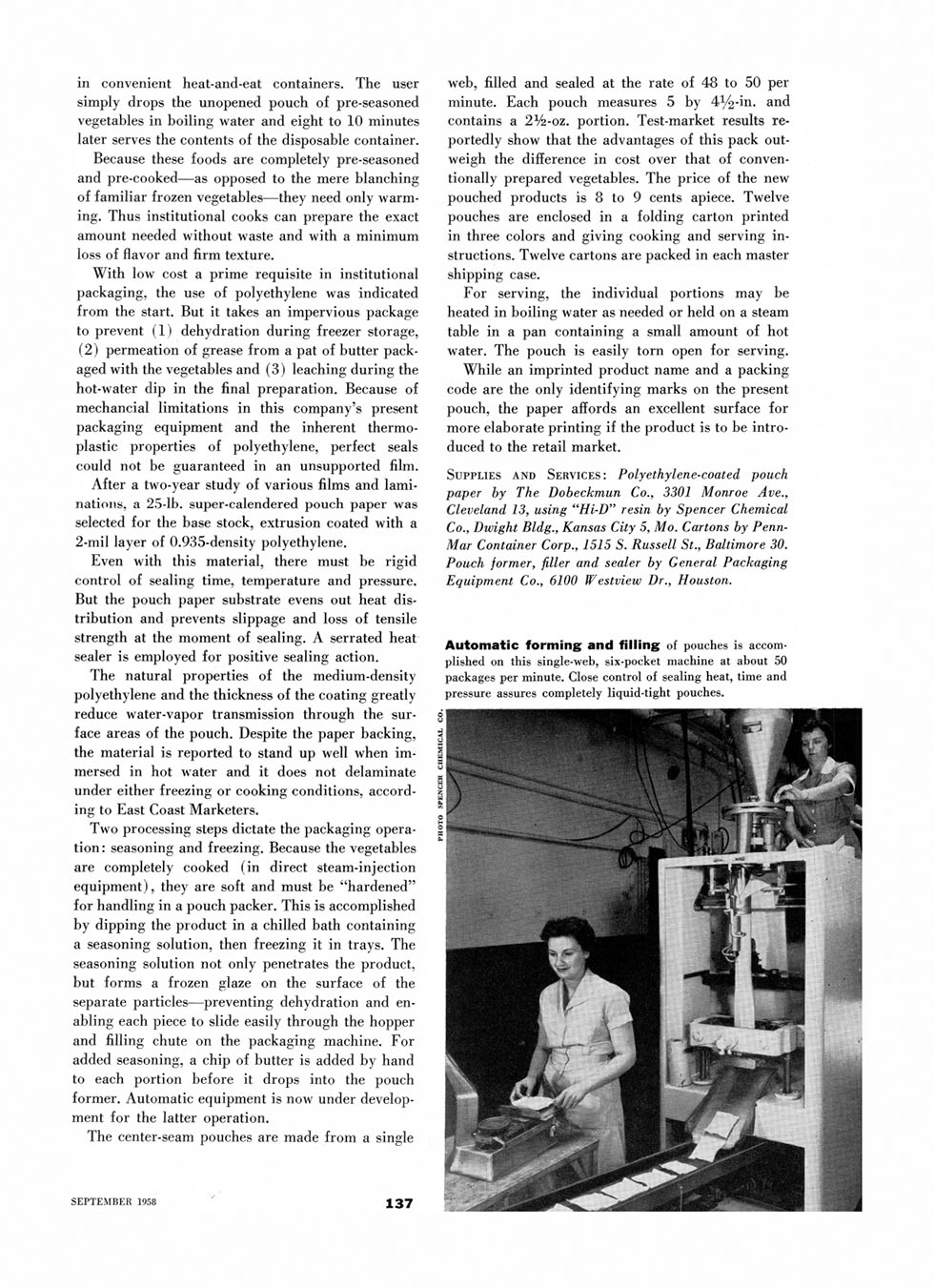


in convenient heat-and-eat containers. The user simply drops the unopened pouch of pre-seasoned vegetables in boiling water and eight to 10 minutes later serves the contents of the disposable container.
Because these foods are completely pre-seasoned and pre-cooked as opposed to the mere blanching of familiar frozen vegetable-”they need only warming. Thus institutional cooks can prepare the exact amount needed without waste and with a minimum loss of flavor and firm texture.
With low cost a prime requisite in institutional packaging, the use of polyethylene was indicated from the start. But it takes an impervious package to prevent (1) dehydration during freezer storage,
(2) permeation of grease from a pat of butter packaged with the vegetables and (3) leaching during the hot-water dip in the final preparation. Because of mechancial limitations in this company's present packaging equipment and the inherent thermoplastic properties of polyethylene, perfect seals could not be guaranteed in an unsupported film.
After a two-year study of various films and laminations, a 25-lb. super-calendered pouch paper was selected for the base stock, extrusion coated with a 2-mil layer of 0.935-density polyethylene.
Even with this material, there must be rigid control of sealing time, temperature and pressure.
But the pouch paper substrate evens out heat distribution and prevents slippage and loss of tensile strength at the moment of sealing. A serrated heat sealer is employed for positive sealing action.
The natural properties of the medium-density polyethylene and the thickness of the coating greatly reduce water-vapor transmission through the sur- g face areas of the pouch. Despite the paper backing, < the material is reported to stand up well when im- |
mersed in hot water and it does not delaminate *
under either freezing or cooking conditions, accord- § ing to East Coast Marketers. "
Two processing steps dictate the packaging opera- | tion: seasoning and freezing. Because the vegetables are completely cooked (in direct steam-injection equipment), they are soft and must be "hardened"ť for handling in a pouch packer. This is accomplished by dipping the product in a chilled bath containing a seasoning solution, then freezing it in trays. The seasoning solution not only penetrates the product, but forms a frozen glaze on the surface of the separate particle-”preventing dehydration and enabling each piece to slide easily through the hopper and filling chute on the packaging machine. For added seasoning, a chip of butter is added by hand to each portion before it drops into the pouch former. Automatic equipment is now under development for the latter operation.
The center-seam pouches are made from a single
web, filled and sealed at the rate of 48 to 50 per minute. Each pouch measures 5 by 4½-in. and contains a 2½-oz. portion. Test-market results reportedly show that the advantages of this pack outweigh the difference in cost over that of conventionally prepared vegetables. The price of the new pouched products is 8 to 9 cents apiece. Twelve pouches are enclosed in a folding carton printed in three colors and giving cooking and serving instructions. Twelve cartons are packed in each master shipping case.
For serving, the individual portions may be heated in boiling water as needed or held on a steam table in a pan containing a small amount of hot water. The pouch is easily torn open for serving.
While an imprinted product name and a packing code are the only identifying marks on the present pouch, the paper affords an excellent surface for more elaborate printing if the product is to be introduced to the retail market.
Supplies and Services: Polyethylene-coated pouch paper by The Dobeckmun Co., 3301 Monroe Ave., Cleveland 13, using "Hi-D99 resin by Spencer Chemical Co., Dwight Bldg., Kansas City 5, Mo. Cartons by Penn-Mar Container Corp., 1515 S. Russell St., Baltimore 30. Pouch former, filler and sealer by General Packaging Equipment Co., 6100 Westview Dr., Houston.
Automatic forming and filling of pouches is accomplished on this single-web, six-pocket machine at about 50 packages per minute. Close control of sealing heat, time and pressure assures completely liquid-tight pouches.